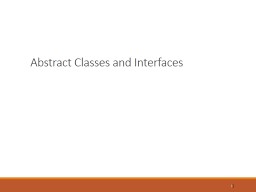

1 2 Abstract Classes and Abstract Methods 2 GeometricObject Circle Rectangle 3 abstract method in abstract class 3 An abstract method cannot be contained in a nonabstract class If a subclass of an abstract superclass does not implement all the abstract methods the subclass must be ID: 997774
Download Presentation The PPT/PDF document "1 Abstract Classes and Interfaces" is the property of its rightful owner. Permission is granted to download and print the materials on this web site for personal, non-commercial use only, and to display it on your personal computer provided you do not modify the materials and that you retain all copyright notices contained in the materials. By downloading content from our website, you accept the terms of this agreement.
1. 1Abstract Classes and Interfaces1
2. 2Abstract Classes and Abstract Methods2GeometricObjectCircleRectangle
3. 3abstract method in abstract class 3An abstract method cannot be contained in a nonabstract class. If a subclass of an abstract superclass does not implement all the abstract methods, the subclass must be defined abstract. In other words, in a nonabstract subclass extended from an abstract class, all the abstract methods must be implemented, even if they are not used in the subclass.
4. 4object cannot be created from abstract class 4An abstract class cannot be instantiated using the new operator, but you can still define its constructors, which are invoked in the constructors of its subclasses. For instance, the constructors of GeometricObject are invoked in the Circle class and the Rectangle class.
5. 5abstract class without abstract method 5A class that contains abstract methods must be abstract. However, it is possible to define an abstract class that contains no abstract methods. In this case, you cannot create instances of the class using the new operator. This class is used as a base class for defining a new subclass.
6. 6superclass of abstract class may be concrete 6A subclass can be abstract even if its superclass is concrete. For example, the Object class is concrete, but its subclasses, such as GeometricObject, may be abstract.
7. 7concrete method overridden to be abstract 7A subclass can override a method from its superclass to define it abstract. This is rare, but useful when the implementation of the method in the superclass becomes invalid in the subclass. In this case, the subclass must be defined abstract.
8. 8abstract class as type 8You cannot create an instance from an abstract class using the new operator, but an abstract class can be used as a data type. Therefore, the following statement, which creates an array whose elements are of GeometricObject type, is correct. GeometricObject[] geo = new GeometricObject[10];
9. 9Interfaces vs. Abstract ClassesIn an interface, the data must be constants; an abstract class can have all types of data.Each method in an interface has only a signature without implementation; an abstract class can have concrete methods.9Variables ConstructorsMethodsAbstract classNo restrictions Constructors are invoked by subclasses through constructor chaining. An abstract class cannot be instantiated using the new operator. No restrictions. InterfaceAll variables must be public static finalNo constructors. An interface cannot be instantiated using the new operator.All methods must be public abstract instance methods
10. 10Interfaces vs. Abstract Classes, cont.10All classes share a single root, the Object class, but there is no single root for interfaces. Like a class, an interface also defines a type. A variable of an interface type can reference any instance of the class that implements the interface. If a class extends an interface, this interface plays the same role as a superclass. You can use an interface as a data type and cast a variable of an interface type to its subclass, and vice versa.
11. 11Caution: conflict interfaces In rare occasions, a class may implement two interfaces with conflict information (e.g., two same constants with different values or two methods with same signature but different return type). This type of errors will be detected by the compiler. 11
12. 12Whether to use an interface or a class?Abstract classes and interfaces can both be used to model common features. How do you decide whether to use an interface or a class? In general, a strong is-a relationship that clearly describes a parent-child relationship should be modeled using classes. For example, a staff member is a person. So their relationship should be modeled using class inheritance. A weak is-a relationship, also known as an is-kind-of relationship, indicates that an object possesses a certain property. A weak is-a relationship can be modeled using interfaces. For example, all strings are comparable, so the String class implements the Comparable interface. You can also use interfaces to circumvent single inheritance restriction if multiple inheritance is desired. In the case of multiple inheritance, you have to design one as a superclass, and others as interface. 12